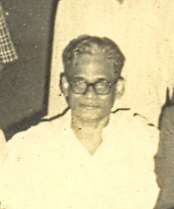Binod Kanungo
| Binod Kanungo | |
|---|---|
 | |
| Native name | Binod Kanungo |
| Born |
6 June 1912 Mallipur, Cuttack District, Odisha |
| Died |
June 22, 1990 Cuttack, Odisha |
| Nationality | Indian |
Binod Kanungo is a renowned Odia author, freedom fighter, Gandhian, educator, social reformer and celebrated compiler of the Gyana Mandala, which is the greatest encyclopaedia in the Odia language. He also won the Odisha Sahitya Akademi Award for his travelogue Runa Parishodha (1983). He was also a veteran freedom fighter and notable educationist. He was awarded with India's fourth highest civilian honour "Padmashree".[1] He died on 22 June 1990.
Early life and education
Kanungo was born on 6 June 1912 at village Mallipur (Kishannagar) in Cuttack district of Odisha. He was the only son of Keshub Chandra Kanungo and Peera Dei. He had his primary education at village Naganpur and secondary school education at the famous Ranihat Highschool, Cuttack, of which he was the first ever student. Later he got a scholarship to study at Ravenshaw Collegiate School. However, in 1930, when he was in Class-X, Mahatma Gandhi's call inspired him to leave his studies and join the Indian Freedom Movement.
Career as a journalist and social reformer
Kanungo was appointed by the daily newspaper The Samaja to cover Mahatama Gandhi's Harijan Padayatra from Puri to Bhadrak in 1934. During this period Gandhiji taught, advised and groomed Binod Kanungo in the art of news reporting. Later he worked with the eminent Gandhian Gopabandhu Choudhury and joined The Samaja as an Assistant Editor. He was jailed for his participation in the freedom struggle. In 1952 he fought the first general elections in India and lost.
Work on Jnanmandal
In 1954 he set his sight on compiling the monumental Oriya encyclopedia Jnanmandal. The first volume was released on 2 December 1960 by Harekrushna Mahatab, the then Chief Minister of Odisha. He compiled and edited major part of the Jnanmandal at his Barabati Stadium office at Cuttack. He single handedly built the reference centre, which was visited and extolled by a great many dignitaries during his time, including Pranab Mukherjee, who later became President of India. Jnanmandal has been hailed as one of the best edited and most lucid encyclopedia in any of the modern Indian languages. During his lifetime he created the Jnanmandal Foundation which is carrying on his work till today. After his death, the Foundation has created and published different kinds of multi-volume encyclopedias both for young and adult readers. In the meanwhile, two more editions of Jnanmandal has been released. The latest and third edition (10 Vols) has been published this year i.e. 2014. It consists of thousands of topics in popular Oriya comprising all branches of human knowledge and is profusely illustrated.
Notable works
Although Jnanmandal was his magnum opus, he wrote numerous popular books in Odia including travelogues, biographies, children's books and also more than a hundred books on science and technology. He set up the Jnanmandal Foundation for the propagation of encyclopedic knowledge among common people at affordable cost. He devoted his entire life to the popularization of science and technical knowledge.
Some of his booklets written for the children on various topics are listed below (incomplete, there are about 30 such booklets):
- duishaha chha khandi kaaunri kathi (206 magical sticks) - a book on human orthopaedics
- baDanka baDei rahilaa naahin ( ) -
- chalanta raaijara amuhaan naee (mouthless river of the moving kingdom) - blood circulatory system of human beings
- naa debaaTaa keDe kashta (its so difficult naming) - on naming conventions of various systems
Awards and honours
He won Odisha Sahitya Akademi Award in 1984 for his semi-autobiographical travelogue Runa Parishodha.[2] He was honoured by the President of India with the coveted Padmashree title.
On 2 May 2013, a statue of Binod Kanungo was installed on the premises of the Odisha State Archives.[3] A museum is being built in Bhubaneswar to display the rare collections and manuscripts of Binod Kanungo.[4]